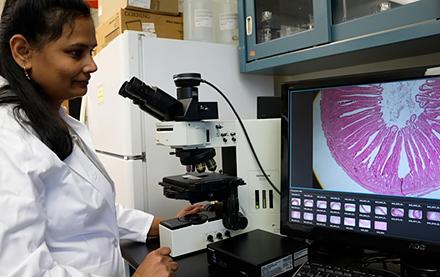Mycotoxins Can Be A Shot to the Gut of Poultry

ARS research biologist Revathi Shanmugasundaram at the Toxicology and Mycotoxin Research Unit.
ARS Researchers Assessed Whether Mycotoxins in Poultry Feed Could Predispose Chickens to Fatal Disease, Even at Low Levels
Corn and corn byproducts are among the biggest components of poultry feed in the United States. They provide necessary nutrients and fiber to sustain growth in chickens and other animals. Unfortunately, corn can be susceptible to different mycotoxins, including aflatoxins, a family of carcinogenic toxins produced by fungi that commonly grow on corn and other food crops.
“With corn being an integral part of poultry feed in the U.S., economic loss due to mycotoxins is estimated at $900 million per year,” said Revathi Shanmugasundaram, research biologist at ARS’s National Poultry Research Center in Athens, GA. “Mycotoxin contamination of corn and feed must be reduced, and eventually eliminated, for optimal poultry health and production.”
Farmers are allowed to use corn and other agricultural feed ingredients that contain mycotoxins at low levels, as set by the Food and Drug Administration (FDA). The poultry industry employs screening tests for determining mycotoxin levels in their feed. However, these tests can be false or misleading because multiple mycotoxins can co-occur together and can also be masked by carbohydrates, fats, and other constituents of feed. Masking is a major concern since mycotoxin contamination may be underestimated. ARS researchers noted that 92% of poultry feed samples analyzed in 2021 contained more than one mycotoxin.
The poultry industry uses mycotoxin binders to counteract aflatoxins in the feed, but the major mycotoxin binders, such as clay minerals, are not effective against most other mycotoxins, such as fumonisins and deoxynivalenol, because their chemical structures are not suitable for adsorption by binders.
“Fumonisins and deoxynivalenol in particular are causing huge economic losses to the poultry industry,” said Shanmugasundaram. “The poultry industry needs to reevaluate the effects of multiple mycotoxins on poultry health and performance.”
Shanmugasundaram looked at the data gaps in risk assessment of different mycotoxins in poultry feed. In particular, she studied whether multiple mycotoxins found in poultry feed could damage a chicken’s intestine and gut walls and lead to fatal diseases. In-feed mycotoxins are one of the predisposing factors that cause damage to the gut wall, leading to a loss in gut integrity. Changes in gut integrity have been linked to the growth of bad bacteria such as Clostridium perfringens, which can lead to subclinical or clinical necrotic enteritis, a disease that can cause high mortality in chickens, especially young chickens.
“We wanted to find out if the intestinal epithelial damage caused by in-feed mycotoxins, even at individual mycotoxin levels below the FDA recommendations, could predispose chickens to necrotic enteritis, a disease of economic importance in poultry,” said Shanmugasundaram.
Shanmugasundaram determined that fumonisins and deoxynivalenol found in the poultry diet had a negative impact on body weight gain and feed conversion ratio (a measure of how efficiently feed is converted to an animal’s body weight), altered small intestinal morphology, and significantly increased the incidence and severity of necrotic enteritis in broiler chickens. Notably, these negative impacts occurred despite fumonisins and deoxynivalenol being present at concentrations well below the recommended FDA guidelines. The subclinical mycotoxin levels decreased the bird’s production performance by 10.5% compared to unexposed birds, in large part due to increased damage to the gut. Across the industry, that reduction could amount to millions in losses.
“This research has significant practical importance and reflects a real-world problem because of the common occurrence of multiple mycotoxins in poultry feeds,” Shanmugasundaram said. “This study could have a significant positive impact on the poultry industry because the data may provide a scientific basis for reevaluating the regulatory standards and compliance guidelines for fumonisins and deoxynivalenol concentrations in the poultry feed diet.” — Todd Silver, ARS Office of Communications.

